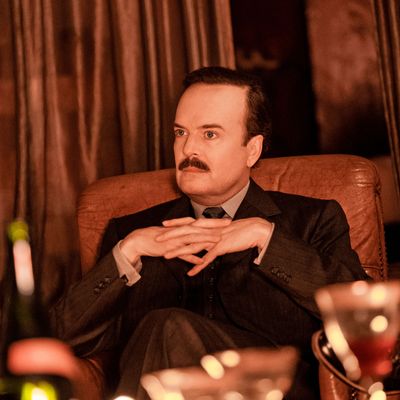
TNT’s I Am the Night is a reasonably well-made drama with one great performance, but it’s impossible to shake the feeling that what the program has accomplished in three episodes could have just as easily been accomplished in one. In screenplay terms, it feels like we’re at the end of the first act, finally getting our two protagonists together and starting to draw the line between the Black Dahlia murder and one creepy George Hodel. Chris Pine has done nuanced, strong work — he’s the main thing keeping the show interesting — but there’s no dramatically resonant reason that it’s taken three episodes to get here. Let’s hope the pace improves in the back half of the six-episode limited series.
“Dark Flower” opens in 1945, two years before the Black Dahlia murder. There’s a truly creepy shindig going down at the Hodel estate. It’s very Eyes Wide Shut, with men in masks and women in lingerie. Tamar Hodel peeks around the corner at the action, which gets truly kinky, especially for TNT. There’s a terrifying animal mask on George’s head, a hood placed over a woman, and some other weird kinky sides being explored, along with a notable threat of violence. The implication is clearly that the Hodel mansion was a place where sexual danger lurked around every corner, and Tamar Hodel was watching a lot of it. Roll credits!
Back in 1965, Fauna Hodel walks down a dark street as she’s grabbed by Sepp, George’s super-creepy right-hand man. He claims to be able to explain a few things to her, but he’s aggressive and scary too. She’s offered a ride by a cop, but declines. Fauna can’t find a friend.
Meanwhile, Jay is having a bad dream about his time in Korea — his PTSD will play a major role this week — when the cops break down the door. The truly awful Billis wants to talk to him. Actually, he just wants to threaten him. One of the episode’s strongest scenes unfold as the two exchange insults, Billis calling Jay “failure” and Jay pointing out the fear that makes a violent man like Billis hide behind a badge. Billis doesn’t take constructive criticism, throwing the cuffed Jay to the ground and nearly gouging out his eye with a pencil, before Jay’s cop buddy — who we learn was saved by Jay in Korea — intervenes to save him.
Barely aware that Sepp is tracking her every move when he’s not busy building some strange violin mannequin sex thing in his basement, Fauna goes back to the Hodel estate, looking for her mother. She finds her way upstairs and goes through the mail, finding a return address from Tamar on a piece of mail postmarked last week. She also finds disturbing photos on the wall and George’s creepy sex animal mask just hanging there, along with an article about hysterectomies. TV is famous for the occasional exposition dump, so call this is an exposition photo tableau. Fauna realizes that the icky guy she saw at the bus stop was George, her grandfather, and she flees just before getting caught snooping by Sepp.
Meanwhile — and the chronology here is super-weird in that this is intercut with Fauna arriving at the Hodels, but also has to end in time for Jay to get there to see Fauna leaving — Jay goes to talk to his editor pal Peter about the Hodel story again. It doesn’t go well. Jay suggests that the reason Billis roughed him up is because Jay is getting close to a big story. What if there’s an illegal abortion clinic being protected by the LAPD? That would be a scoop. A man falls to the floor when his chair tips over and Jay hits the floor. A jerk even calls him “shellshock,” and Jay loses it, punching the guy who fell (he shoulda gone after the jerk) and needing to be pulled off.
Literally moments later, he’s spying on the Hodels, when Fauna goes scurrying down the drainpipe. He chases after her, and she flees. Just then, Sepp pulls up and Fauna has to make a choice as to which stalker she leaves the intersection with. She chooses Jay, finally getting our two leads together. She’s not giving much information to Jay, and he’s not exactly being forthcoming either. It’s kind of an unbelievable dynamic. Fauna needs information about her family and Jay may have it. Why would she run from him other than “because TV”?
That’s exactly what she does after the episode’s best scene, which takes place at a diner where Jay pays Fauna $5 to talk to him. He says he wrote about Tamar a long time ago, and she calls Tamar a liar. They’re feeling each other out as to what each knows and what to reveal. What do each of them need? And then Fauna takes off before it can get actually interesting.
Jay is furious, taking it out on his steering wheel, and doing some drugs as the smooth jazz kicks in on the soundtrack. He drives up to an Armed Forces Recruiting Center and is apparently high enough to try to enlist to go to Vietnam. He’s denied, of course; he’s too old. He’s moseying back to his car when he spots a bookstore with a tabloid paper in the window. The cover story is about the Black Dahlia. The score amps up even more. Jay is putting some clues together like good reporters do.
After a scene that reveals just how much Sepp is the Igor to George Hodel’s Dr. Frankenstein, Fauna comes back to her cousin’s place to find everyone in mourning. Someone killed Nero, cutting out his tongue and tying it into a knot. Was it because he was flirting with Fauna? She thinks so, and so she leaves, ending up on her friend Terrence’s couch. She calls home but gets rebuffed by her mother. She has no place to go.
Neither does Jay, apparently, as he’s dozing off in his car, back in the company of his junkie gal pal. He looks through the tabloid, pulling the photos of the murdered Janice Brewster from the back seat and comparing them to Elizabeth Short, a.k.a. the Black Dahlia. What if the killers are the same? As Jay is realizing this connection, George Hodel walks his hallway, hearing growling and stomping. He looks under a door to see cloven hooves. The devil has returned to the Hodel home.
Hush Hush
• This is as good a time as any to share this fascinating piece in which Steve Hodel asserts that his father, George Hodel, was the Black Dahlia killer. As someone who’s read a lot about L.A.’s most famous unsolved mystery, I think that while Hodel isn’t the only suspect, he’s certainly a prime one.
• Of course, Elizabeth Short’s murder is a real tragedy, but I’ve yet to find any online evidence that the Janice Brewster case is based on a real one.
• Wondering what super-creepo George Hodel was muttering over scenes of his kinky sex parties in the opening scene? It was “A Dream Within a Dream” by Edgar Allan Poe.
• The team behind I Am the Night is doing an interesting job in selecting L.A. landmarks. They’re less interested in obvious ones, finding a place like Chili John’s to set Fauna and Jay’s first meeting. It’s still there.


